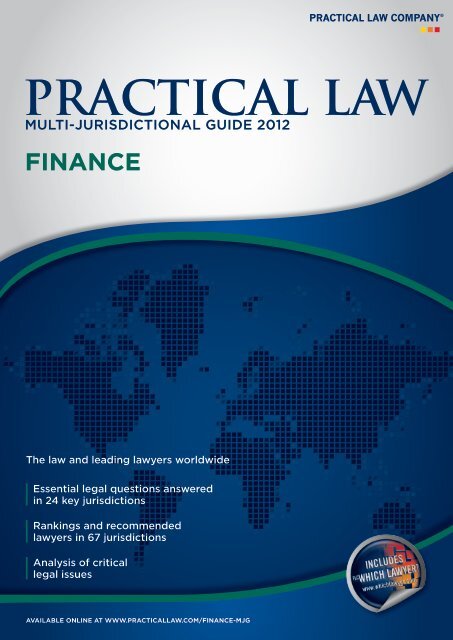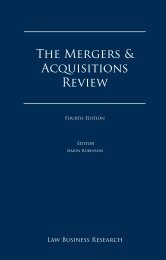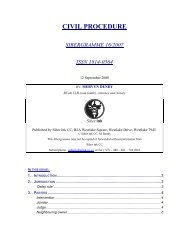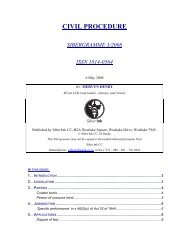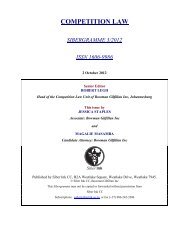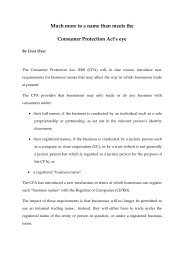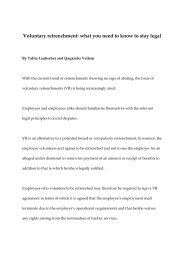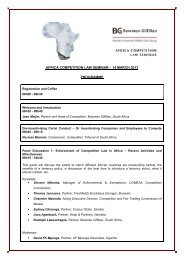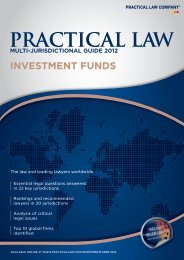PRACTICAL LAW - Bowman Gilfillan Attorneys
PRACTICAL LAW - Bowman Gilfillan Attorneys
PRACTICAL LAW - Bowman Gilfillan Attorneys
You also want an ePaper? Increase the reach of your titles
YUMPU automatically turns print PDFs into web optimized ePapers that Google loves.
<strong>PRACTICAL</strong> <strong>LAW</strong><br />
MULTI-JURISDICTIONAL GUIDE 2012<br />
FINANCE<br />
The law and leading lawyers worldwide<br />
Essential legal questions answered<br />
in 24 key jurisdictions<br />
Rankings and recommended<br />
lawyers in 67 jurisdictions<br />
Analysis of critical<br />
legal issues<br />
AVAILABLE ONLINE AT WWW.<strong>PRACTICAL</strong><strong>LAW</strong>.COM/FINANCE-MJG
MULTI-JURISDICTIONAL GUIDE 2012<br />
FINANCE<br />
South Africa<br />
Ulrike Naumann and Lionel Shawe<br />
<strong>Bowman</strong> <strong>Gilfillan</strong> Inc<br />
www.practicallaw.com/2-384-6156<br />
OVERVIEW OF THE LENDING MARKET<br />
1. What have been the main trends and important developments<br />
in the lending market in your jurisdiction in the last 12<br />
months?<br />
The lending market in South Africa has seen renewed activity with a<br />
number of smaller private equity buyouts and other corporate action<br />
being funded by bank-lending. The last year has also seen a renewed<br />
interest in alternative funding mechanisms (such as the issuance of<br />
high yield bonds) and the lending market will continue to feel some<br />
pressure from these alternative funding sources in the near future.<br />
The lending market has had to take into account the changes to<br />
South African company law introduced by the Companies Act 2008<br />
(New Companies Act), which came into force on 1 May 2011 and<br />
made some significant changes to the corporate framework.<br />
considered to be immovable property. Otherwise, these objects<br />
or buildings (for example, buildings without foundations, such as<br />
sheds, railway lines and all fixtures or annexations to buildings)<br />
are not immovable property.<br />
An intangible asset is classified as immovable property if the<br />
tangible asset to which it relates is itself classified as immovable<br />
property (for example, mineral rights).<br />
Common forms of security<br />
Security over immovable property can only be obtained by a<br />
special mortgage of immovable property as set out in the Deeds<br />
Registries Act 1937 (DRA) (see below, Formalities).<br />
A mortgage bond does not transfer title in the mortgaged immovable<br />
property to the lender. It confers a limited real right on the lender<br />
to have the immovable property sold in execution, and the proceeds<br />
of that sale applied to settle, or reduce, the debt secured by the<br />
mortgage bond.<br />
FORMS OF SECURITY OVER ASSETS<br />
Real estate<br />
2. What is considered real estate in your jurisdiction? What are<br />
the most common forms of security granted over it? What<br />
formalities are required?<br />
Real estate<br />
South African law defines real estate as “immovable property”,<br />
there is no exhaustive list of what constitutes immovable property<br />
but the following are always classified as immovable property:<br />
Formalities<br />
A special mortgage of immovable property is created by a mortgage<br />
bond. A mortgage bond is perfected by registering it at the same<br />
deeds registry where the immovable property over which the bond<br />
is granted is registered. No other method can confer a valid security<br />
over immovable property.<br />
Tangible movable property<br />
3. What is considered tangible movable property in your<br />
jurisdiction? What are the most common forms of security<br />
granted over it? What formalities are required?<br />
Country Q&A<br />
• Land, minerals in the soil, trees (unless in the act of falling)<br />
and growing crops of fruit.<br />
• A building annexed to the land, if its attachment to the land<br />
is so secure that separation from it would cause substantial<br />
injury to either the land or the building. This includes all<br />
buildings or structures with foundations in the soil.<br />
• An object which is attached to immovable property (for<br />
example, to a building which is itself immovable property),<br />
if its attachment to the immovable property is so secure<br />
that separation from it would cause substantial injury to<br />
either the immovable property or the article.<br />
Whether buildings or objects that have separate identity and<br />
can be detached with relative ease, without causing substantial<br />
damage to the immovable property on which they are situated<br />
are considered to be part of immovable property depends on the<br />
intentions of the owner. If the owner’s intention was that these<br />
objects or buildings should be annexed permanently, they are<br />
Tangible movable property<br />
Movable property is anything which can be moved from place<br />
to place without damage to itself. Generally, all property which<br />
is not immovable property is classified as movable property. A<br />
further distinction is drawn between:<br />
• Tangible movable property, which can be handled or touched.<br />
• Intangible movable property, which cannot be handled or<br />
touched (for example, intellectual property, book debts and<br />
shares) (see Questions 4 to 7).<br />
Tangible movable property includes aircraft and ships. There are<br />
particular formalities applying to aircraft and ships (see below,<br />
Common forms of security).<br />
Common forms of security<br />
The most common forms of security that can be granted over<br />
tangible movable property are outlined below.<br />
© This article was first published in the Finance multi-jurisdictional guide 2012<br />
and is reproduced with the permission of the publisher, Practical Law Company.
MULTI-JURISDICTIONAL GUIDE 2012<br />
FINANCE<br />
Country Q&A<br />
Pledge. A pledge is a type of mortgage of movable property given<br />
by a borrower (pledgor) in favour of a lender (pledgee) as security<br />
for a debt or other obligation. A pledge can be used as security<br />
for both tangible and intangible movable property.<br />
General notarial bond. A general notarial bond is a mortgage by<br />
a borrower of all of its tangible movable property in favour of a<br />
lender as security for a debt or other obligation. However, a general<br />
notarial bond does not (in the absence of attachment of the<br />
property before insolvency) make the lender a secured creditor of<br />
the borrower. Consequently, it is not a true mortgage of movable<br />
property, but is a means of obtaining a limited statutory preference<br />
above the claims of concurrent creditors in the borrower’s insolvent<br />
estate (see Question 27).<br />
Special notarial bond. A special notarial bond is a mortgage which:<br />
• Is created over the tangible movable property (which can be<br />
specifically identified) of a borrower as security for a debt or<br />
other obligation.<br />
• Meets the requirements outlined in the Security by Means<br />
of Movable Property Act 1993 (see below, Formalities).<br />
• Is registered under the DRA.<br />
A special notarial bond (once registered) constitutes real security<br />
in the mortgaged property as effectively as if it had been expressly<br />
pledged and actually delivered to the lender. Title to the movable<br />
property remains with the borrower, subject to the lender’s security<br />
interest. Since property subject to a special notarial bond must<br />
be specifically identified, it is not appropriate for creating security<br />
over changing (fungible) assets (see Question 8, Fungible assets).<br />
Landlord’s hypothec. If rent is due and payable, but has not been<br />
paid, the lessor has a hypothec (an encumbrance giving a creditor<br />
a security interest in a debtor’s movable property for so long as<br />
the movable property is on the leased property), unless the contrary<br />
is agreed. The hypothec provides the lessor with a real right<br />
of security, allowing the lessor to attach and execute the lessee’s<br />
property to satisfy payment of the arrears.<br />
Aircraft. Security over an aircraft (or a share in an aircraft) can<br />
only be created by a deed of mortgage in the prescribed form<br />
under the Recognition of Rights in Aircraft Act 1993, as set out in<br />
the Mortgaging of Aircraft Regulations 1997. The Convention on<br />
International Interests in Mobile Equipment 2001 and the Protocol<br />
to the Convention on International Interests in Mobile Equipment<br />
on Matters Specific to Aircraft Equipment 2001 were made law in<br />
South Africa by the Convention on International Interests in Mobile<br />
Equipment Act 2007. As a result, the relevant interests constitute<br />
an international interest, and can be enforced by third-party creditors<br />
where the asset is located in South Africa. A general, or special,<br />
notarial bond cannot be created or registered over an aircraft.<br />
Ships. Security over a South African ship (or a share in a South<br />
African ship) can only be created by a mortgage in the prescribed<br />
form under the Ship Registration Act 1998. The prescribed from<br />
is set out in the Ship Registration Regulations 2002. A general, or<br />
special, notarial bond cannot be created or registered over a ship.<br />
Formalities<br />
Pledge. An agreement must be created between the lender and the<br />
borrower together with delivery of the pledged movable property<br />
to the lender (or its agent). Title to the movable property remains<br />
with the borrower, subject to the lender’s security interest. There<br />
are no registration or notification requirements for a pledge.<br />
General notarial bond. The DRA does not prescribe a form for a<br />
general notarial bond. The bond must be prepared by a notary<br />
public, and is executed either:<br />
• By the owner of the movable property subject to the bond.<br />
• By a notary public under a formal power of attorney granted<br />
to him by the mortgagor.<br />
Typically, a bond contains both:<br />
• An acknowledgement of debt by the borrower for the<br />
amount of the bond.<br />
• A declaration binding the borrower’s movable property in<br />
favour of the lender as security for the debt acknowledged.<br />
A general notarial bond must be registered at the deeds registry<br />
within three months after the date of its execution.<br />
Special notarial bond. A special notarial bond for tangible movable<br />
property must identify and describe the property secured in a manner<br />
which makes the property readily recognisable. The DRA does<br />
not prescribe a particular form for this bond. It must be registered<br />
in the manner prescribed in the DRA and must be registered at the<br />
deeds registry within three months after the date of its execution.<br />
Landlord’s hypothec. There are no formalities.<br />
Aircraft. The Commissioner for Civil Aviation will record a mortgage<br />
over an aircraft on the production of a deed of mortgage and payment<br />
of the prescribed fee. The mortgage is recorded in the register<br />
kept by the Commissioner for Civil Aviation.<br />
Ships. A deed of mortgage over a ship must be presented to the<br />
Registrar of Ships and registered in the South African Ships Register.<br />
Financial instruments<br />
4. What are the most common types of financial instrument<br />
over which security is granted in your jurisdiction? What<br />
are the most common forms of security granted over those<br />
instruments? What formalities are required?<br />
Financial instruments<br />
The most common types of financial instruments over which<br />
security can be granted are shares and debt securities.<br />
Common forms of security<br />
Security over financial instruments is usually created by either a<br />
pledge (see Question 3, Common forms of security) or a cession<br />
in security (or a combination of these).<br />
A cession in security is a way of granting security over intangible<br />
movable property. It is created by the debtor (cedant) granting<br />
security by way of cession over intangible movable property in<br />
the creditor’s (cessionary’s) favour. It can be structured as either:<br />
• A cession in securitatem debiti where title to the property<br />
remains with the cedant (as with a pledge).<br />
• An out-and-out cession, where title to the property is<br />
transferred to the cessionary, subject to the cedant’s right<br />
to have the property transferred back to it by the cessionary<br />
once the debt, or other obligation secured, is discharged.<br />
FOR MORE<br />
INFORMATION<br />
about this publication, please visit www.practicallaw.com/finance-mjg<br />
about Practical Law Company, please visit www.practicallaw.com/about/practicallaw
MULTI-JURISDICTIONAL GUIDE 2012<br />
FINANCE<br />
Formalities<br />
Where financial instruments are evidenced by certificates, those<br />
certificates are usually delivered with a transfer form to evidence<br />
the security and facilitate its easy enforcement, where necessary.<br />
Where financial instruments are uncertificated, the security is<br />
perfected by recording its existence on the securities account<br />
of the borrower where the financial instrument is registered. In<br />
relation to securities which are listed on a stock exchange, the<br />
securities account of the borrower is flagged in accordance with<br />
the Securities Services Act 2004.<br />
There are no formalities for a cession in security, which is validly<br />
created once the agreement to grant security has been reached.<br />
Claims and receivables<br />
5. What are the most common types of claims and receivables<br />
over which security is granted in your jurisdiction? What are<br />
the most common forms of security granted over claims and<br />
receivables? What formalities are required?<br />
Common forms of security<br />
The form of security will depend on the type of intellectual property<br />
right over which security is being taken.<br />
Patents. Security over patents can be taken either by:<br />
• A hypothecation under the Patents Act 1978 (section<br />
60(5)). A hypothecation is the practice where a borrower<br />
pledges collateral to secure a debt.<br />
• A cession in security (see Question 4, Common forms of<br />
security).<br />
Trade marks. Security over registered trade marks can be taken<br />
either by:<br />
• A hypothecation of trade marks under a deed of security<br />
under the Trade Marks Act 1993.<br />
• A cession in security.<br />
Copyright. Security over a copyright can only be taken by a cession<br />
in security.<br />
Claims and receivables<br />
Claims and receivables include book debts and other rights under<br />
contracts such as insurance contracts and are commonly granted<br />
in South Africa.<br />
Common forms of security<br />
Security over claims and receivables is usually created by a<br />
cession in security (see Question 4, Common forms of security).<br />
Formalities<br />
There are no specific perfection requirements for a cession in<br />
security, as the act of cession itself is sufficient to perfect the<br />
security.<br />
Cash<br />
6. What are the most common forms of security over cash<br />
deposits?<br />
Security over cash deposits is usually created by a cession in<br />
security of the borrower’s bank account (see Question 4, Common<br />
forms of security).<br />
Intellectual property<br />
7. What are the most common types of intellectual property<br />
over which security is granted in your jurisdiction? What are<br />
the most common forms of security granted over intellectual<br />
property? What formalities are required?<br />
Designs. Security over registered designs can be taken either by:<br />
• A hypothecation under the Designs Act 1993 (section<br />
30(5)).<br />
• A cession in security.<br />
In the absence of a registered hypothecation, a transfer of intellectual<br />
property to a third party can be validly effected despite a<br />
lender’s security interest. If the hypothecation has been registered<br />
against the intellectual property right, then the proprietor cannot<br />
voluntarily license the right to third parties.<br />
Formalities<br />
Patents. A hypothecation must:<br />
• Be recorded in writing.<br />
• Be lodged with the Companies and Intellectual Property<br />
Commission, together with Form P16 application to record<br />
the hypothecation.<br />
• Have the application served on the registered proprietor of<br />
(or applicant for) the patent, as well as any other parties<br />
recorded on the register as having an interest in the patent.<br />
Proof of service must be provided to the Registrar of<br />
Patents.<br />
Trade marks. The formalities for hypothecation are the same as<br />
those for patents (see above, Patents). However, Form TM6 must<br />
be used to record the hypothecation.<br />
Security over unregistered trade marks is granted by a cession in<br />
security (section 41(1), Trade Marks Act 1993).<br />
Country Q&A<br />
Intellectual property<br />
Intellectual property includes:<br />
• Patents.<br />
• Trade marks.<br />
• Copyright.<br />
• Designs.<br />
Copyright. There are no formalities for creating and perfecting<br />
copyright.<br />
Designs. The formalities for hypothecation are the same as those<br />
for patents (see above, Patents). However, Form D7 must be used<br />
to record the hypothecation.<br />
FOR MORE<br />
INFORMATION<br />
about this publication, please visit www.practicallaw.com/finance-mjg<br />
about Practical Law Company, please visit www.practicallaw.com/about/practicallaw
MULTI-JURISDICTIONAL GUIDE 2012<br />
FINANCE<br />
Problem assets<br />
8. Are there types of assets over which security cannot be<br />
granted or can only be granted with difficulty? Which assets<br />
are difficult or problematic when security is granted over<br />
them?<br />
type of security. Certain forms of security require a further act to<br />
release the security, for instance the cancellation of a mortgage<br />
bond, special notarial bond or general notarial bond at the deeds<br />
registry.<br />
In addition, parties can enter into a release agreement to govern<br />
the release of security.<br />
Country Q&A<br />
Future assets<br />
To create genuine security in an asset, the asset must be delivered,<br />
or deemed to be delivered, to the creditor. For intangible assets,<br />
it is now generally accepted that rights to future intangible<br />
assets can be granted as security. However, when dealing with<br />
immovable assets, or intangible movable assets, at best there<br />
can only really be an undertaking by the debtor to deliver the<br />
asset (or procure the registration of a bond over the asset) once<br />
that asset is in its possession. This undertaking is nothing more<br />
than a contractual undertaking, which affords no real security. A<br />
general notarial bond can be passed over all present and future<br />
movable property, but until the property is attached and taken<br />
into the possession of the creditor, no real security is created (see<br />
Question 3, Common forms of security).<br />
Intangible assets present difficulties regarding the granting of<br />
security. A person’s right to grant security over an intangible asset<br />
can be restricted by common law, by agreement and by statute.<br />
Under common law the principal restrictions on a person’s right<br />
to cede an intangible asset are that:<br />
• A third-party debtor’s position cannot be burdened by the<br />
cession. Therefore, a cession of a portion of a debt is not<br />
valid without the third-party debtor’s consent.<br />
• A cession which deprives a third-party debtor of a right of setoff<br />
is invalid if the debtor and the creditor have acted in bad<br />
faith to deprive the third-party debtor of the right of set-off.<br />
• Purely personal rights are incapable of cession (for example,<br />
the rights of partners against each other), as are rights<br />
under employment contracts.<br />
Fungible assets<br />
Taking security over tangible movable fungible assets presents<br />
difficulties, as the asset must be delivered to the holder of the<br />
security to create real security. A security interest in a tangible<br />
movable fungible asset is usually created using a general notarial<br />
bond, but a general notarial bond will only give the security holder a<br />
limited security interest (see Question 3, Common forms of security).<br />
Other assets<br />
The law governing taking security over minerals in the soil, and<br />
mineral rights, is complex. Restrictions on granting security<br />
over these assets are contained in the Mineral and Petroleum<br />
Resources Development Act 2002.<br />
RELEASE OF SECURITY OVER ASSETS<br />
9. How are common forms of security released? Are any<br />
formalities required?<br />
Generally, once a principal obligation of a borrower is discharged,<br />
the security accessory to the principal obligation is automatically<br />
released, whether there are further formalities depends on the<br />
SPECIAL PURPOSE VEHICLES (SPVs) IN<br />
SECURED LENDING<br />
10. Is it common in your jurisdiction to take security over the<br />
shares of an SPV set up to hold certain of the borrower’s<br />
assets, rather than to take direct security over those assets?<br />
Security SPVs are commonly used to create security where there are<br />
multiple lenders. The security SPV is established, which grants a<br />
guarantee to the lenders for the obligations of a borrower under a loan<br />
agreement. The borrower in turn provides an indemnity to the security<br />
SPV and the borrower secures its obligations under the indemnity by<br />
granting security to the security SPV. The shares in the security SPV<br />
are usually held by an owner trust or other administrative party. The<br />
owner trust or administrative party can be required to grant a pledge to<br />
the lenders over the shares it holds in the security SPV, although this<br />
is not a common feature of these structures.<br />
QUASI-SECURITY<br />
11. What types of quasi-security structures are common in<br />
your jurisdiction? Is there a risk of such structures being<br />
recharacterised as a security interest?<br />
Sale and leaseback<br />
In a sale and leaseback, the owner of an asset sells it to a buyer,<br />
who then leases it back to the owner (in its capacity as lessee).<br />
The lease period is equivalent to the useful life of the asset<br />
and the rental payments are equal to the purchase price plus<br />
financing costs. The commercial effect of a sale and leaseback<br />
is similar to a secured loan to the owner in respect of the asset.<br />
Factoring<br />
In a factoring transaction (also known as a discounting transaction),<br />
the owner (seller) of receivables sells its receivables to a buyer<br />
(factor) for a discounted amount. Ownership of the receivables<br />
passes to the buyer, the benefit of which to the buyer being that,<br />
in the event of the insolvency of the seller (assuming proper title<br />
transfer) the receivables do not fall into the estate of the seller.<br />
Transfer of the receivables is effected by an out-and-out cession<br />
of the rights in the receivables being sold. Factoring is completed<br />
either on a “without recourse” or a “with recourse” basis. In<br />
without recourse factoring, the buyer (factor) assumes the risk<br />
of non-payment by the debtors. In with recourse factoring, the<br />
seller of the receivables assumes the risk (wholly or partly) of nonpayment<br />
by the debtors. Factoring is commercially equivalent to<br />
a loan secured by a security interest over receivables. The risks<br />
associated with factoring are as follows:<br />
• Care must be taken to ensure that the consent of the<br />
debtor is not required to transfer ownership of the relevant<br />
receivables, otherwise a transfer made without consent will<br />
not be effective against the debtor.<br />
FOR MORE<br />
INFORMATION<br />
about this publication, please visit www.practicallaw.com/finance-mjg<br />
about Practical Law Company, please visit www.practicallaw.com/about/practicallaw
MULTI-JURISDICTIONAL GUIDE 2012<br />
FINANCE<br />
• While notification of the transfer of the receivables is not<br />
required for a valid transfer of ownership to the buyer,<br />
failure to notify the debtors continues to entitle them to<br />
make payment of the receivables to the seller in discharge<br />
of their obligations. In such circumstances the buyer<br />
(factor) will have no recourse to the debtor.<br />
• Care must be taken to ensure that a valid transfer of<br />
ownership in the receivables occurs by way of a valid outand-out<br />
cession of the rights to the receivables.<br />
Hire purchase<br />
A hire purchase transaction is a lease transaction which usually<br />
includes an option for the lessee to purchase the asset for an<br />
agreed (and sometimes nominal) amount at the end of the period<br />
of the lease. However, it can also provide that on payment of<br />
the last rental, ownership passes to the lessee without the need<br />
to exercise an option. This is a common method of financing<br />
movable assets, where a bank or financial institution acquires<br />
the asset of its customer, and then enters into a hire purchase<br />
transaction with the customer in respect of the asset.<br />
All the risks and rewards of ownership of the asset are generally<br />
passed to the lessee, and so hire purchase contracts are also known as<br />
finance leases. If the lessee becomes insolvent before exercising the<br />
option, the lessor remains the owner of the asset. This is commercially<br />
equivalent to a secured loan in respect of the asset. The major risk<br />
associated with a hire purchase arrangement is ensuring that the<br />
lessor takes title to, and becomes the owner of, the asset.<br />
Retention of title<br />
This involves the sale of an asset where the buyer takes possession<br />
of the asset, but title to the asset remains with the seller until<br />
the purchase price (including a finance charge element) has<br />
been paid in full. The seller of an asset (typically a bank or<br />
financial institution) will acquire the asset from a supplier at the<br />
purchaser’s request, and then sell it to the purchaser for a price<br />
(including a finance charge element). This type of transaction<br />
is also known as an instalment sale, where the purchaser pays<br />
the purchase price in instalments over an agreed period. This is<br />
commercially equivalent to a transfer of title to the buyer, who<br />
grants a security interest over the asset as security for payment<br />
of the purchase price. The major risk associated with a retention<br />
of title arrangement is ensuring that the seller takes title to,<br />
and becomes the owner of, the asset from the supplier. If the<br />
purchaser of the asset then becomes bankrupt, or is liquidated,<br />
for the purposes of winding up the estate of the purchaser, the<br />
asset is treated as forming part of the estate of the purchaser,<br />
subject to a security interest. The amount still due under the<br />
transaction is secured (the seller of the asset does not have an<br />
absolute right of retention on the insolvency of the purchaser).<br />
Other structures<br />
The other structures are:<br />
• Sale and repurchase agreement (repo transaction). Under<br />
this arrangement an entity transfers absolute title in a<br />
fungible asset (typically a security) to another entity.<br />
In return, the transferee undertakes to transfer another<br />
security, equivalent to the original security, back to the<br />
transferor at the end of the transaction. On default, the<br />
parties’ respective obligations terminate and are offset.<br />
• Rights of set-off. This contractual arrangement allows a lender<br />
to consolidate a loan, or set-off the loan balance, against<br />
money in the borrower’s bank account. Set-off also occurs by<br />
operation of law where debts in liquid form are mutually owed<br />
and simultaneously due and payable between two parties.<br />
Risk of recharacterisation as a security interest<br />
These structures are permitted under South African law and are<br />
unlikely to be recharacterised as security interests if the parties<br />
genuinely intend the contracts to have the effects stated. Sale and<br />
leaseback transactions have a higher risk of recharacterisation (as<br />
a loan secured by a security interest over the relevant asset),<br />
although the South African Supreme Court of Appeal has held<br />
that the risk of recharacterisation is low if both:<br />
• The parties genuinely intend ownership to pass to the<br />
purchaser (lessor) of the asset.<br />
• The parties give effect to that intention by transferring<br />
ownership by a legally recognised method.<br />
Application of the National Credit Act 2005<br />
The National Credit Act 2005 governs the extension of credit<br />
by credit providers. It applies to the lease element of a sale and<br />
leaseback transaction, and to hire purchase and retention of title<br />
structures (unless they fall into one of the exemptions provided<br />
for in the Act). The exemptions include:<br />
• Where the consumer is a legal person whose asset value or<br />
annual turnover, together with the combined asset value or<br />
annual turnover of all related legal persons, at the time the<br />
agreement is made, equals or exceeds ZAR1 million (as at 1<br />
December 2011, US$1 was about ZAR8.3).<br />
• Where there is an agreement for a principal sum in excess<br />
of ZAR250,000, and the consumer is a legal person whose<br />
asset value or annual turnover is, at the time the agreement<br />
is made, below ZAR1 million.<br />
NEGATIVE PLEDGE<br />
12. Are negative pledge clauses commonly used in your<br />
jurisdiction?<br />
Negative pledge clauses are commonly contained in loan<br />
documents in South Africa. A negative pledge is a contractual<br />
obligation where one party to the contract undertakes to the other<br />
party that it will not, in relation to all or certain parts of its property:<br />
• Sell it.<br />
• Create any security interest(s) over it.<br />
• Create any quasi-security interest(s) over it.<br />
A negative pledge creates no rights (real or personal) in the assets<br />
that are subject to the undertaking, and only creates a contractual<br />
promise giving rise to a personal right on the part of the beneficiary of<br />
the undertaking (for example, to enforce specific performance of the<br />
contractual promise). However, the risk is that specific performance<br />
remains a discretionary remedy in South African courts.<br />
GUARANTEES<br />
13. Are guarantees commonly used in your jurisdiction? How are<br />
they created?<br />
Guarantees are commonly used in South Africa, to create an<br />
obligation on the guarantor (who is not the borrower) in relation to<br />
a lending transaction. The obligations of the guarantor are often<br />
Country Q&A<br />
FOR MORE<br />
INFORMATION<br />
about this publication, please visit www.practicallaw.com/finance-mjg<br />
about Practical Law Company, please visit www.practicallaw.com/about/practicallaw
MULTI-JURISDICTIONAL GUIDE 2012<br />
FINANCE<br />
secured by the guarantor granting a security interest in favour of<br />
the lender. Guarantees are also used as part of a security SPV<br />
structure (see Question 8).<br />
RISK AREAS FOR LENDERS<br />
14. Do any laws affect the validity of a loan, security or guarantee<br />
(or the terms on which they are made or agreed)?<br />
Usury<br />
The rate of interest which can be charged by a lender under a<br />
credit agreement can be subject to limitations imposed by the<br />
National Credit Act 2005.<br />
15. Can a lender be liable under environmental laws for the<br />
actions of a borrower, security provider or guarantor?<br />
Country Q&A<br />
Financial assistance<br />
Unless the company’s constitutive documents provide otherwise,<br />
the board can authorise the company to provide financial<br />
assistance to any person for the purpose of, or in connection with,<br />
the subscription or purchase of options or securities issued or to<br />
be issued by the company or a related or inter-related company,<br />
subject to certain requirements (section 44, Companies Act 2008).<br />
The board cannot authorise financial assistance unless both:<br />
• It is pursuant to either:<br />
• an employee share scheme that satisfies the<br />
requirements of section 97 of the Companies Act 2008;<br />
• a special resolution of the shareholders, adopted within<br />
the previous two years, which approved the assistance<br />
either for:<br />
<br />
<br />
the specific recipient; or<br />
a category of potential recipients into which the<br />
specific recipient falls.<br />
• The board of the company granting financial assistance is<br />
satisfied that:<br />
• immediately after providing the financial assistance the<br />
company will satisfy the solvency and liquidity test; and<br />
• the terms relating to the financial assistance are fair<br />
and reasonable to the company.<br />
The board must ensure that any conditions or restrictions concerning<br />
the provision of financial assistance contained in the<br />
company’s constitutive documents are satisfied.<br />
Section 45 of the Companies Act 2008 which regulates the granting<br />
of financial assistance to a related or inter-related company<br />
imposes substantially the same requirements as section 44 of the<br />
Companies Act 2008 set out above.<br />
Corporate benefit<br />
Directors breach their fiduciary duties if they allow the company<br />
to enter into a transaction (such as a grant of guarantee or<br />
security) which is not in the company’s best interests. This is not<br />
usually problematic in downstream guarantees (guarantees made<br />
by a parent company to its subsidiary), as the parent company<br />
can usually show that it derives some benefit from its subsidiary’s<br />
increased financial strength.<br />
The National Environmental Management Act 1998 and the<br />
National Water Act 1998 extend the net of liability to include,<br />
among others, persons who are responsible for or who have directly<br />
or indirectly contributed to pollution or degradation, or negligently<br />
failed to prevent the activity being performed that resulted in the<br />
pollution or degradation. Whilst the ambit of this terminology<br />
has not been tested in South African courts, it is possible that in<br />
certain circumstances, liability may extend to include a lender for<br />
the actions of a borrower, security provider or guarantor.<br />
STRUCTURING THE PRIORITY OF DEBTS<br />
16. What methods of subordination are there?<br />
Contractual subordination<br />
It is possible to contractually subordinate a debt, and contractual<br />
subordination is common in South Africa. Subordination is achieved<br />
by agreement either between the debtor and the creditors concerned,<br />
or between the creditors concerned. Subordination of a debt<br />
can also be created for the benefit of third-party creditors who are<br />
not a party to the agreement. There is no need to comply with any<br />
specific formalities to conclude a subordination agreement, other<br />
than compliance with the normal principles required to create a<br />
valid contract.<br />
Structural subordination<br />
It is possible to structurally subordinate a debt. Structural<br />
subordination is common in South Africa and can be achieved by<br />
lending at different levels of a group structure.<br />
Intercreditor arrangements<br />
Intercreditor arrangements are common in South Africa. Parties<br />
to intercreditor agreements typically include the relevant lenders<br />
and a security SPV. Intercreditor agreements usually provide for<br />
the manner in which parties are to exercise their rights under loan<br />
and/or security documentation.<br />
DEBT TRADING AND TRANSFER MECHANISMS<br />
17. Is debt traded in your jurisdiction and what transfer<br />
mechanisms are used? How do buyers ensure that they<br />
obtain the benefit of the security and guarantees associated<br />
with the transferred debt?<br />
Loans to directors<br />
The provisions in relation to loans to directors are contained<br />
in section 45 of the Companies Act 2008 and are similar to<br />
those regarding the granting of financial assistance (see above,<br />
Financial assistance).<br />
Secured debt is regularly traded in South Africa. Rights to security<br />
associated with transferred debt are usually transferred by the<br />
cession of the transferring creditor’s rights in the security. If the<br />
rights granted include rights under mortgage bonds or notarial<br />
bonds, the cession must be registered at a deeds registry.<br />
FOR MORE<br />
INFORMATION<br />
about this publication, please visit www.practicallaw.com/finance-mjg<br />
about Practical Law Company, please visit www.practicallaw.com/about/practicallaw
MULTI-JURISDICTIONAL GUIDE 2012<br />
FINANCE<br />
If only part of a debt is transferred, the debtor’s consent to the<br />
transfer must be obtained (unless the document giving rise to the<br />
debt expressly permits the transfer of part of the debt without the<br />
debtor’s consent).<br />
If a security SPV structure has been used (see Question 10), the<br />
guarantee granted by the security SPV usually stipulates that it<br />
is granted for the benefit of all holders of the debt for which the<br />
guarantee was granted, including transferees. If the guarantee<br />
does not contain this statement, the transferring lender usually<br />
transfers the rights under the guarantee to the extent of the debt<br />
transferred.<br />
AGENT AND TRUST CONCEPTS<br />
• Parallel debt obligation. A parallel debt obligation can be<br />
created where an obligation is created in the documentation<br />
owed by the borrower to the security trustee, which is<br />
equivalent to the obligation owed to the lenders. This<br />
security is then passed in the security trustee’s favour as<br />
security for the parallel debt obligation.<br />
• Security SPV structure (see Question 10).<br />
SECURITY AND LOAN DOCUMENTATION<br />
20. Do the different types of security in your jurisdiction need to<br />
be documented separately or does your jurisdiction allow a<br />
single security document?<br />
18. Is the agent concept (such as a facility agent under a<br />
syndicated loan) recognised in your jurisdiction?<br />
The different types of security are documented separately (see<br />
Questions 2 to 8).<br />
An agency arrangement created under the law of another country<br />
is generally recognised in South Africa.<br />
Lenders in syndicated loan or funding structures can appoint one<br />
of the finance parties to perform the role of facility agent. The<br />
facility agent role is purely administrative.<br />
The facility agent can enforce rights on behalf of the other<br />
syndicate lenders in South African courts on the instructions of<br />
the relevant finance parties, if the relevant security documents<br />
authorise it to do so.<br />
19. Is the trust concept recognised in your jurisdiction?<br />
21. What (if any) are the rules on how loans (including syndicated<br />
loans) should be documented for the loan to be enforceable?<br />
There are no specific rules on how a loan should be documented<br />
for it to be enforceable.<br />
ENFORCEMENT OF SECURITY INTERESTS AND<br />
BORROWER INSOLVENCY<br />
22. What are the circumstances in which a lender can enforce its<br />
loan, guarantee or security interest? What requirements must<br />
the lender comply with?<br />
The trust concept is recognised in South Africa. A trust created<br />
under the law of another jurisdiction is recognised, and a security<br />
trustee can enforce its contractual rights in South African courts.<br />
However, it is uncertain whether security can validly be created<br />
in favour of a security trustee acting as trustee for a group of<br />
lenders. This is because for a security to be lawful, a valid<br />
principal obligation (in other words, not an accessory obligation)<br />
must be owed to the granter of that security, and the security<br />
trustee arrangement lacks this requirement. This problem cannot<br />
be overcome by having the security documents governed by a<br />
foreign law, since the proper law for a security document granting<br />
security over property situated in South Africa is South African<br />
law. In addition, the registration of mortgage bonds and notarial<br />
bonds where security is granted in favour of an agent for a<br />
principal is prohibited (DRA). There is a risk under South African<br />
law that a security trustee can be seen as an agent for the lenders<br />
in relation to the security, with the result that the security was<br />
therefore not validly created.<br />
There are three main ways to grant security which help to overcome<br />
the problem of the security trustee:<br />
• Joint and several security. The security is granted in favour<br />
of the lenders jointly and severally. This is not commonly<br />
used as it is complex to apply and there are a number of<br />
risks associated with it (for an example, an invalid splitting<br />
of claims). The structure has also not been tested by the<br />
South African courts.<br />
Since security is an accessory obligation (that is, an obligation<br />
that is dependent on the existence, or coming into existence, of<br />
a valid and effective principal obligation), the secured creditor<br />
can enforce its security on the default of the principal obligation.<br />
Methods of enforcement<br />
23. How are the main types of security interest usually enforced?<br />
What requirements must a lender comply with?<br />
With certain types of security (such as security conferred by way<br />
of a cession in security, a pledge and a special notarial bond), the<br />
secured creditor can, without prior judgment against, or pursuit<br />
of, the security provider, procure the sale of the secured assets<br />
and apply the proceeds to satisfy the principal obligation.<br />
For mortgage bonds or general notarial bonds, the secured creditor<br />
must first perfect the security by taking possession of the secured<br />
assets. The secured creditor must obtain a court order directing<br />
the sheriff of the High Court to attach the relevant asset. The<br />
secured creditor can then procure a sale of the assets, and apply<br />
the proceeds of the sale to discharge the principal obligation.<br />
In some cases the secured creditor can simply agree with the<br />
borrower that the secured assets are sold without the need for<br />
judicial execution. This is known as parate executie (the right of<br />
a creditor to realise a borrower’s property without first obtaining<br />
a court order). An agreement of parate executie concerning<br />
Country Q&A<br />
FOR MORE<br />
INFORMATION<br />
about this publication, please visit www.practicallaw.com/finance-mjg<br />
about Practical Law Company, please visit www.practicallaw.com/about/practicallaw
MULTI-JURISDICTIONAL GUIDE 2012<br />
FINANCE<br />
movables pledged and delivered to the secured creditor is valid<br />
provided there is no prejudice to the security provider. However,<br />
an agreement of this nature is invalid in relation to security over:<br />
• Immovable property.<br />
• Secured assets not in the possession of the secured creditor<br />
at the time it wishes to enforce its rights.<br />
Rescue, reorganisation and insolvency<br />
least 50% of this 75% above must be amounts owed to independent<br />
creditors (that is, creditors who are neither related to the<br />
company, nor to any of its directors (this excludes shareholders’<br />
loans)). Voting is weighted depending on the size of the claim,<br />
and employees are considered to be independent creditors. If<br />
the business plan is not formulated within a specified time, or<br />
approved by the creditors, the company must go out of business<br />
rescue, or be put into liquidation.<br />
Country Q&A<br />
24. Are company rescue or reorganisation procedures (outside of<br />
insolvency proceedings) available in your jurisdiction? How<br />
do they affect a lender’s rights to enforce its loan, guarantee<br />
or security?<br />
Under the Companies Act 2008, two new company rescue<br />
procedures are available.<br />
Compromise (section 155). This is an arrangement between the<br />
company and its creditors, or certain classes of creditors. The<br />
board of a company or a liquidator can propose an arrangement<br />
or a compromise of the financial obligations of the company to all<br />
of its creditors or to all of the members of a class of its creditors.<br />
The proposal will be adopted if it is supported by a majority in<br />
number representing at least 75% in value of the creditors or<br />
class who are present and voting at a meeting called for that<br />
purpose.<br />
Business rescue proceedings (sections 128 to 154). Business<br />
rescue can be used where a company is financially distressed,<br />
including where a company anticipates being unable to pay<br />
its debts in six months’ time. It includes the sale of the whole<br />
business to generate a better return than a liquidation dividend<br />
would manage. A company can invoke business rescue by filing<br />
a resolution at the Companies Office. To dispute this, a creditor<br />
must then make a court application and prove that the proposed<br />
business rescue would fail.<br />
Once business rescue proceedings are commenced, a<br />
moratorium is imposed on all claims (secured and unsecured).<br />
The moratorium runs from the date the board resolution is filed<br />
(and, consequently, before notice is given to creditors and other<br />
affected persons). If a shareholder or creditor applies to the court<br />
to have the company placed into business rescue, the moratorium<br />
applies as soon as the application is issued. Following the board<br />
resolution, or court application, for business rescue, the board<br />
of directors stay in office throughout the business rescue period.<br />
The company must appoint a business rescue practitioner. The<br />
practitioner can both:<br />
• Suspend (entirely, partially or conditionally), for the<br />
duration of business rescue, any obligation of the company<br />
arising from any pre-commencement contracts (even if that<br />
obligation arises post-commencement).<br />
• Apply urgently to a court to cancel (entirely, partially or<br />
conditionally), on any terms that are just and reasonable in<br />
the circumstances, any agreement to which the company is<br />
a party.<br />
A business plan must be prepared and voted on by the company’s<br />
creditors. The plan must be approved by creditors whose aggregate<br />
claims against the company comprise at least 75% of the total<br />
value of all amounts owed by the company to all its creditors. At<br />
25. How does the start of insolvency procedures affect a lender’s<br />
rights to enforce its loan, guarantee or security?<br />
Under common law, once insolvency procedures are commenced,<br />
a creditor holding movable or immovable property as security<br />
cannot realise that security itself, but must deliver it to the<br />
liquidator for realisation. The secured creditor must give notice to<br />
the Master of the High Court and (if one has been appointed) the<br />
liquidator, that it holds the security before the second meeting<br />
of creditors. However, a secured creditor can realise movable<br />
property itself provided the following procedures are followed<br />
(Insolvency Act 1936):<br />
• If the property is a class of property usually sold through a<br />
stockbroker, the creditor can, before the second meeting of<br />
creditors, sell the property through a stockbroker (or if the<br />
creditor is a stockbroker, through another stockbroker).<br />
• If the property is a financial instrument, the creditor can,<br />
before the second meeting of creditors, sell the property<br />
either:<br />
• through a financial instrument trader; or<br />
• to another financial instrument trader or financial<br />
instrument principal if the creditor is a financial<br />
instrument trader or a financial instrument principal.<br />
• If the property is a bill of exchange the creditor can, before<br />
the second meeting of creditors, realise it in any manner<br />
approved by the liquidator or the Master of the High Court.<br />
• If the property is a right of action, the creditor cannot<br />
realise it without the approval of the liquidator or the Master<br />
of the High Court.<br />
• If the property is any other property the creditor can, before<br />
the second meeting of creditors, sell the property by public<br />
auction after giving:<br />
• the liquidator a reasonable opportunity to inspect it;<br />
• notice of the time and place of the sale as directed by<br />
the liquidator.<br />
Where a secured creditor realises the security of an insolvent<br />
borrower, the creditor must pay the net proceeds to the liquidator.<br />
The secured creditor is only entitled to a payment out of such<br />
proceeds if its claim is proved and admitted under the Insolvency<br />
Act.<br />
Where a secured creditor values its security when proving its<br />
claim the liquidator can, unless the security has already been<br />
realised, take over the relevant movable or immovable property<br />
at the value placed on it by the creditor. Take over means the<br />
liquidator buying the property from the creditor for an amount<br />
equal to the value placed on it, effectively settling the claim and<br />
freeing the property from the creditor’s rights.<br />
FOR MORE<br />
INFORMATION<br />
about this publication, please visit www.practicallaw.com/finance-mjg<br />
about Practical Law Company, please visit www.practicallaw.com/about/practicallaw
MULTI-JURISDICTIONAL GUIDE 2012<br />
FINANCE<br />
26. What transactions involving loans, guarantees, or security<br />
interests can be made void if the borrower, guarantor or<br />
security provider becomes insolvent?<br />
The Insolvency Act allows the court to set aside dispositions<br />
made by an insolvent debtor in the following cases.<br />
Disposition without value<br />
A court will set aside an insolvent debtor’s disposition where<br />
the liquidator can prove that it falls within one of the following<br />
categories:<br />
• Dispositions of property made more than two years before<br />
the liquidation of the insolvent debtor’s estate, where:<br />
• immediately after making the disposition, the liabilities<br />
of the insolvent debtor exceeded its assets; and<br />
• the disposition was not made for value.<br />
• Dispositions of property made within two years of the<br />
liquidation of the insolvent debtor’s estate which were<br />
not for value. The disposition will not be set aside if the<br />
person who benefitted from the disposition can prove that,<br />
immediately after making the disposition, the insolvent’s<br />
assets exceeded its liabilities.<br />
In either case, where it is proved that at any time after making the<br />
disposition the insolvent debtor’s liabilities exceeded its assets<br />
by an amount less than the value of the property disposed of,<br />
the disposition will only be set aside to the extent of that excess.<br />
Voidable preferences<br />
The court can set aside a disposition where all the following<br />
apply:<br />
• It is made by an insolvent debtor within six months before<br />
the date of liquidation.<br />
• It has the effect of preferring one creditor over another.<br />
• Immediately after the disposition, the liabilities of the<br />
insolvent debtor exceeded the value of its assets.<br />
The setting aside of a disposition can be avoided where the person<br />
who benefitted from the disposition can prove that it was both:<br />
• Made in the ordinary course of the debtor’s business.<br />
• Not intended to prefer one creditor over another.<br />
Undue preference to creditors<br />
The court can set aside a disposition of property made by a debtor<br />
as an undue preference where all the following apply:<br />
• The debtor’s liabilities exceed its assets.<br />
• It was made with the intention of preferring one creditor<br />
over another.<br />
• The debtor’s estate is subsequently liquidated.<br />
• No time limit applies.<br />
27. In what order are creditors paid on the borrower’s insolvency?<br />
Secured assets<br />
A secured creditor is a creditor who holds security for its claim in<br />
the form of a (Insolvency Act):<br />
• Special mortgage (including a mortgage bond, special<br />
notarial bond and general notarial bond).<br />
• Landlord’s hypothec.<br />
• Pledge.<br />
• Right of retention.<br />
Each secured creditor whose security is properly perfected has<br />
a secured claim over the property constituting its security. The<br />
Insolvency Act provides the methods by which a secured creditor’s<br />
security can be realised. A proven secured claim must be paid in<br />
priority to any other claim from the realisation of that property, after<br />
the deduction of liquidation costs. The creditor is responsible for<br />
those costs, which represent the costs of maintaining, conserving<br />
and realising the property. Where secured creditors have security<br />
over the same asset, the creditor granted security earlier in time has<br />
a higher-ranking claim in respect of that asset (see Question 28).<br />
A lender under a general notarial bond that takes possession of any<br />
of the property subject to the bond before the borrower’s liquidation<br />
also becomes a secured creditor in respect of the property<br />
taken into its possession. Where a lender under a general notarial<br />
bond has not taken possession of the property subject to the bond,<br />
it remains an unsecured creditor.<br />
Free residue<br />
Whatever remains of the estate once the secured creditors’ claims<br />
have been settled is called the free residue and is applied in the<br />
following order:<br />
• The costs of liquidation and the costs of execution.<br />
• Proved preferential claims to which the Insolvency Act (or<br />
any other statute) has assigned a preference, including:<br />
• the salary and wages of employees (and certain other<br />
amounts payable to, or on behalf of, employees);<br />
• certain statutory obligations (for example, amounts owing<br />
to the workmen’s compensation fund, unemployment<br />
insurance fund, value added or other sales taxes and<br />
amounts owing to other statutory bodies);<br />
• taxes.<br />
• Proved preferential claims arising from bonds giving<br />
preferences (such as general notarial bonds) (see Question<br />
29). The bondholder is entitled to payment out of the<br />
borrower’s movable property before any concurrent (that is,<br />
unsecured) creditor. The preference is only given in respect<br />
of the movable property subject to the general notarial<br />
bond. Once the holder of a general notarial bond goes into<br />
possession of the property secured, it becomes a secured<br />
creditor (see above, Secured assets).<br />
Country Q&A<br />
FOR MORE<br />
INFORMATION<br />
about this publication, please visit www.practicallaw.com/finance-mjg<br />
about Practical Law Company, please visit www.practicallaw.com/about/practicallaw
MULTI-JURISDICTIONAL GUIDE 2012<br />
FINANCE<br />
• Proved concurrent claims (that is, claims which are neither<br />
secured nor preferential). Concurrent claims include any<br />
claim for the unpaid amount of any proved secured claim<br />
(unless the secured creditor concerned has waived its<br />
right to have the balance of the claim paid out of the free<br />
residue). A secured creditor will usually waive this right<br />
when the free residue is insufficient to cover the liquidation<br />
costs (in which case, creditors with proved claims are liable<br />
for a proportionate share of such costs) (see above, Secured<br />
assets). Concurrent claims are paid in proportion to the<br />
amount of each concurrent claim in the insolvent estate.<br />
• Subordinated creditors, if they have subordinated their<br />
claims to the claims of concurrent creditors.<br />
• Shareholders (holders of preference shares generally take<br />
priority to holders of ordinary shares).<br />
28. If more than one lender holds the same security interest over<br />
the same asset, how is priority between them determined? Do<br />
any specific ranking rules apply?<br />
Where multiple creditors are granted the same security interest<br />
over the same asset at different times, the creditor granted<br />
security first takes priority (see Question 27). Creditor(s) granted<br />
security after the first-in-time creditor will generally only have<br />
security over the debtor’s reversionary interest in the asset.<br />
It is possible for creditors to agree to rank equally (pari passu)<br />
when creating a security interest over immovable property. It is<br />
also possible to grant security over the same asset to multiple<br />
creditors jointly and severally, although this form of joint and<br />
several security is complicated.<br />
• Creating a loan from a South African resident to a foreign<br />
borrower.<br />
• Granting a guarantee from a South African resident in<br />
favour of a non-resident, or granting a guarantee from a<br />
non-resident in favour of a South African resident.<br />
31. Are there exchange controls that restrict payments to a<br />
foreign lender under a security document, guarantee or loan<br />
agreement?<br />
Payments to foreign creditors arising from loan agreements or<br />
security documents require exchange control approval at the<br />
time the loan is granted, or the security is given. Where exchange<br />
control approval has been granted, an authorised dealer in foreign<br />
exchange will permit the repatriation of the proceeds of any<br />
appropriate realisation.<br />
32. Is a foreign choice of law clause in a security, guarantee<br />
or loan agreement recognised and applied by the courts<br />
in your jurisdiction? Does local law always apply in certain<br />
circumstances?<br />
South African law applies to a security document granting security<br />
over movable, or immovable, property situated in South Africa. A<br />
South African court will not recognise a foreign choice of law<br />
clause in a security document and will apply South African law in<br />
determining whether the security interest was validly granted and<br />
is enforceable under South African law. However, a South African<br />
court will recognise and enforce a foreign choice of law clause in<br />
a loan agreement or guarantee.<br />
Country Q&A<br />
29. If a security interest has not been validly perfected, where<br />
does the security holder rank on the borrower’s insolvency?<br />
If a security interest has not been validly perfected, the security<br />
holder is not considered a secured creditor in respect of that<br />
asset, and ranks as a concurrent creditor (see Question 27).<br />
TAXES AND FEES ON LOANS, GUARANTEES AND<br />
SECURITY INTERESTS<br />
33. Are taxes or fees paid on the granting and enforcement of a<br />
loan, guarantee or security?<br />
However, the holder of a security interest under a general<br />
notarial bond will rank as a preferential creditor in respect of the<br />
borrower’s movable assets, even where the general notarial bond<br />
is not perfected by the security holder by attaching the relevant<br />
assets before the borrower’s insolvency.<br />
CROSS-BORDER ISSUES ON LOANS<br />
30. Are there restrictions on the making of loans by foreign<br />
lenders or granting security (over all forms of property) or<br />
guarantees to foreign lenders?<br />
Security over movable or immovable property can be granted in<br />
favour of foreign lenders. However, the borrower must obtain the<br />
prior approval of the South African Reserve Bank (SARB) to allow<br />
a South African resident to validly grant the security.<br />
The prior approval of the Financial Surveillance Department of<br />
the SARB is also required before:<br />
• Creating a loan from a foreign lender to a South African<br />
resident.<br />
Documentary taxes<br />
No documentary taxes are payable in connection with the granting,<br />
or taking, of security.<br />
Registration fees<br />
Nominal registration fees are payable for the registration of:<br />
• Mortgage bonds.<br />
• General notarial bonds.<br />
• Special notarial bonds.<br />
• Aircraft mortgages.<br />
• Ship mortgages.<br />
• Hypothecations relating to trade marks, designs and patents.<br />
Notaries’ fees<br />
Conveyancers (in relation to mortgage bonds) and notaries<br />
public (in relation to notarial bonds) are entitled to charge fees<br />
for preparing bonds. Fees are charged according to a prescribed<br />
tariff, which calculates fees on a sliding scale, based on the sum<br />
secured by the bond.<br />
FOR MORE<br />
INFORMATION<br />
about this publication, please visit www.practicallaw.com/finance-mjg<br />
about Practical Law Company, please visit www.practicallaw.com/about/practicallaw
MULTI-JURISDICTIONAL GUIDE 2012<br />
FINANCE<br />
Court fees<br />
Nominal court fees are payable on the enforcement of security<br />
where it is necessary to apply to court for an order entitling the<br />
lender to enforce its security. If property is attached and/or sold<br />
in execution, nominal fees are payable to the sheriff of the court<br />
in connection with any attachment and sale in execution.<br />
34. Are there strategies to minimise the costs of taxes and fees<br />
on the granting and enforcement of a loan, guarantee or<br />
security?<br />
The registration fees, court fees and sheriff’s fees (see Question<br />
33) which are charged for the granting or taking of security are<br />
not prohibitively expensive.<br />
Where there is a bond with a large secured sum, the fee charged by<br />
the conveyancer or notary public (once calculated at the prescribed<br />
tariff) can be prohibitively expensive. In these instances, it is usual<br />
for the lender to request a discount on the fee, and discounts of<br />
50% are commonly negotiated.<br />
REFORM<br />
35. Are there any proposals for reform?<br />
The Companies Act 2008 came into force and effect on 1 May<br />
2011. Government is looking to revise the Insolvency Act 1936<br />
and the insolvency provisions relating to companies. There is no<br />
time line for these amendments currently in place.<br />
CONTRIBUTOR DETAILS<br />
ULRIKE NAUMANN<br />
<strong>Bowman</strong> <strong>Gilfillan</strong> Inc<br />
T +27 11 669 9377<br />
F +27 11 669 9001<br />
E u.naumann@bowman.co.za<br />
W www.bowman.co.za<br />
LIONEL SHAWE<br />
<strong>Bowman</strong> <strong>Gilfillan</strong> Inc<br />
T +27 11 669 9325<br />
F +27 11 669 9001<br />
E l.shawe@bowman.co.za<br />
W www.bowman.co.za<br />
Qualified. South Africa, 2007<br />
Areas of practice. Acquisition financing; asset finance;<br />
cross-border finance; debt capital markets; debt<br />
restructuring; high yield debt; lending and syndicated<br />
lending; mineral and resources financing; property finance.<br />
Recent transactions<br />
• Advising Goldman Sachs International and the<br />
co-arrangers and initial purchasers in relation to the<br />
issue of EUR317 million senior secured notes and<br />
US$250 million senior secured notes due 2018, by<br />
Edcon Proprietary Limited.<br />
• Advising Goldman Sachs International and Rand<br />
Merchant Bank as co-arrangers of the ZAR1.01 billion<br />
high yield bonds due 2018 and issued by Edcon<br />
Proprietary Limited and listed on the JSE Limited.<br />
• Advised Rand Merchant Bank and The Standard<br />
Bank of South Africa Limited in connection with the<br />
financing advanced to the acquirer of the McDonald’s<br />
operations in South Africa.<br />
• Advising a large South African cement company in<br />
connection with the restructuring of its senior and<br />
junior debt in an amount of approximate ZAR20 billion.<br />
• Advised the borrower-group in connection with a<br />
EUR350 million multi-tranche syndicated term loan<br />
and revolving facilities for the acquisition of a logistics<br />
company in Germany.<br />
Qualified. South Africa, 1999<br />
Areas of practice. Acquisition financing; asset finance<br />
(including aircraft financing); property finance; minerals and<br />
resources financing; securitisation; debt capital markets;<br />
high yield debt; lending and syndicated lending; cross-border<br />
finance; debt restructuring; derivatives; structured finance; tax.<br />
Recent transactions<br />
• Advised Rand Merchant Bank, Nedbank, Absa Capital<br />
and Investec Bank in connection with a ZAR5.3 billion<br />
acquisition finance facility for Royal Bafokeng Holdings for<br />
the acquisition by Royal Bafokeng Holdings of an increased<br />
stake in RMB Holdings Limited and RMI Holdings Limited.<br />
• Advised Rand Merchant Bank in connection with ZAR800<br />
million financing provided to Titan Funding in connection<br />
with the listing of Brait South Africa.<br />
• Advising a large South African cement company in<br />
connection with the restructuring of its senior and junior<br />
debt of approximately ZAR20 billion.<br />
• Advised Nedbank in connection with a ZAR1 billion<br />
revolving credit facility for Northam Platinum.<br />
• Advised Rand Merchant Bank and Nedbank in connection<br />
with acquisition financing and refinancing facilities for<br />
ACTOM in connection with the acquisition of Savcio<br />
Holdings totalling ZAR5.8 billion.<br />
Country Q&A<br />
FOR MORE<br />
INFORMATION<br />
about this publication, please visit www.practicallaw.com/finance-mjg<br />
about Practical Law Company, please visit www.practicallaw.com/about/practicallaw


